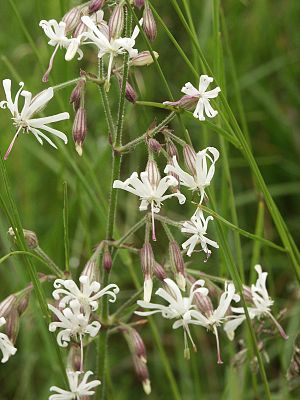Nodding catchfly
| Nodding catchfly | ||||||||||||
|---|---|---|---|---|---|---|---|---|---|---|---|---|

Nodding catchfly ( Silene nutans ) |
||||||||||||
| Systematics | ||||||||||||
|
||||||||||||
| Scientific name | ||||||||||||
| Silene nutans | ||||||||||||
| L. |
The nodding catchfly ( Silene nutans ), also known as the common nodding catchfly , is a species of plant from the genus Leimkräuter ( Silene ) within the carnation family (Caryophyllaceae). The downward sloping ("nodding") flowers unfold and their scent only in the evening to attract moths.
description
Vegetative characteristics
Nodding catchfly grows as a deciduous, perennial herbaceous plant and reaches heights of 25 to 60 centimeters. The unbranched, upright stem is sticky hairy in the upper part. The spatula to egg-shaped basal leaves form a non-flowering rosette. The opposite arranged stem leaves are lanceolate.
Generative characteristics
The flowering period extends from May to September. Before opening, the nodding flowers are in a one-sided inflorescence . The flowers are radial symmetry and five-fold. The cylindrical ten-nerved calyx tube is 6 to 16 millimeters long and hairy glandular. The petals, which are white on the inside and light pink on the outside, are 1.5 to 2.5 centimeters long and narrow and have two columns deep. There is a distinct secondary crown. The stamens, arranged in two circles with five each, clearly protrude above the corolla. The three styles protrude clearly from the corolla.
A capsule fruit is formed.
There is diploidy ; the number of chromosomes is 2n = 24.
ecology
The nodding catchfly is a scleromorphic, mesomorphic hemicryptophyte .
From an ecological point of view, it is a typical moth flower, the flowers of which open in the evening or in cloudy weather and spread an intense hyacinth scent. A small owl butterfly uses the flowers as a breeding ground. This situation is known from palm lilies ( yucca ), but such relationships are rare in the Central European flora.
Occurrence
The nodding catchfly is widespread in the warm temperate areas of Europe and western Siberia . In the Alps you can do it up to an altitude of 2500 meters. encounter. In the Allgäu Alps , it rises in the Tyrolean part on the east ridge of the Rothornspitze to an altitude of 2220 meters. In Germany it is more common in the south than in the north.
The preferred locations are dry grasslands , rock corridors, light forests and forest edges. The plant avoids lime and is found particularly on weathered soils with base-rich silicate rocks. In Central Europe it is a character species of the class Trifolio-Geranietea, but also occurs in societies of the orders Brometalia, Sedo-Scleranthetalia or the associations Violion or Quercion roboris. As ecological indicator values according to Ellenberg , the nodding catchfly is given as a penumbral plant for dry lake to steppe transitional climates. The displayed soil condition is then evenly dry, low in nitrogen and never strongly acidic.
Taxonomy and systematics
It was first published in 1753 by Carl von Linné in Species Plantarum , 1, p. 417. Synonyms for Silene nutans L. are: Silene nutans subsp. smithiana (Moss) Jeanm. & Bocquet , Silene nutans var. Smithiana Moss , Silene nutans var. Brachypoda (Rouy) Molero , Silene brachypoda Rouy , Silene nutans subsp. glabra (DC.) Rothm. , Silene nutans var. Infracta (Kit.) Wahlenb. , Silene nutans L. subsp. nutans .
One can distinguish several subspecies:
- Silene nutans L. subsp. nutans
- Silene nutans subsp. dubia (Rohrb.) Zapalł. : It occurs in Poland, Romania, Slovakia and Ukraine.
- Silene nutans subsp. insubrica (Gaudin) Soldano : It occurs in France, Italy, Austria, Slovenia and on the Balkan Peninsula.
Sources and further information
The article is mainly based on the following documents:
- Gunter Steinbach (Ed.), Bruno P. Kremer u. a .: wildflowers. Recognize & determine. Mosaik, Munich 2001, ISBN 3-576-11456-4 .
Individual evidence
- ↑ Oskar Sebald : Guide through nature. Wild plants of Central Europe. ADAC Verlag, Munich 1989, ISBN 3-87003-352-5 , p. 72.
- ↑ a b Erich Oberdorfer : Plant-sociological excursion flora for Germany and neighboring areas. 8th edition. Verlag Eugen Ulmer, Stuttgart, 2001. ISBN 3-8001-3131-5 . Page 363
- ↑ Erhard Dörr, Wolfgang Lippert : Flora of the Allgäu and its surroundings. Volume 1, IHW, Eching 2001, ISBN 3-930167-50-6 , p. 472.
- ↑ a b c Karol Marhold, 2011: Caryophyllaceae : Datasheet Silene nutans In: Euro + Med Plantbase - the information resource for Euro-Mediterranean plant diversity.
Web links
- Silene nutans L., Nodding catchfly. In: FloraWeb.de.
- Distribution map for Germany. In: Floraweb .
- Profile and distribution map for Bavaria . In: Botanical Information Hub of Bavaria .
- Nodding catchfly . In: BiolFlor, the database of biological-ecological characteristics of the flora of Germany.
- Silene nutans L. s. l. In: Info Flora , the national data and information center for Swiss flora . Retrieved October 8, 2015.
- Profile of wildflowers in Lower Austria .
- Area map in the northern hemisphere to Hultén
- Thomas Meyer: Data sheet with identification key and photos at Flora-de: Flora von Deutschland (old name of the website: Flowers in Swabia )
- Data sheet with photo and distribution in France at Tela-Botanica .
- Data sheet with photos.
- Images: at biopix.dk , at atlas-roslin.pl , at Funghi in Italia - Fiori in Italia - Forum Micologia e Botanica



